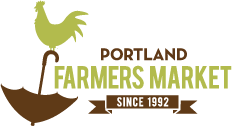Opening My Eyes to Public Markets
By Trudy Toliver, Executive Director, Portland Farmers Market
Last week my job at Portland Farmers Market took me to Cleveland, Ohio. My first trip to Ohio turned out better than I was expecting. I visited a local farmers market as well as a bustling public market, and restaurants in downtown Cleveland and the Ohio City neighborhood served up some scrumptious meals. The occasion was a conference on public markets put on by Project for Public Spaces – a great chance to share ideas and learn how our markets can enhance communities. I can barely wait three years for the next gathering.
 In addition to meetings, we spent Saturday on a field trip. Still attached to my past environmental career, I opted for a visit to the Cuyahoga National Park. Countryside Conservancy runs a farmers market in the midst of the park. It seemed so far away from a neighborhood, but they assured me it’s just minutes from Akron and the small crowd of shoppers verified local interest.
In addition to meetings, we spent Saturday on a field trip. Still attached to my past environmental career, I opted for a visit to the Cuyahoga National Park. Countryside Conservancy runs a farmers market in the midst of the park. It seemed so far away from a neighborhood, but they assured me it’s just minutes from Akron and the small crowd of shoppers verified local interest.
This park unit has reinstated farming into its boundaries. Many of those farmers vend at this market. I wandered among the stalls and enjoyed the tastings including artisan goat cheese from McKenzie Creamery. Turns out, Jean McKenzie is the mother of Liz Alvis who owns Portland Creamery and vends at our NW and Pioneer Courthouse Square markets. Small world.
 I also visited the historical West Side Market, a public market in Ohio City. Celebrating its centennial under the grand architecture of arched ceilings and a clock tower, the elegant market was jammed on Saturday with shoppers and meat from unknown sources. At the fruit and veggie hall next door you can get all the usual grocery store selection of pineapples, star fruit and stickered Washington apples – yet I know Ohio, home to Johnny Appleseed, has orchards. As much as I want to see Washington growers do well, I want local food economies to thrive.
I also visited the historical West Side Market, a public market in Ohio City. Celebrating its centennial under the grand architecture of arched ceilings and a clock tower, the elegant market was jammed on Saturday with shoppers and meat from unknown sources. At the fruit and veggie hall next door you can get all the usual grocery store selection of pineapples, star fruit and stickered Washington apples – yet I know Ohio, home to Johnny Appleseed, has orchards. As much as I want to see Washington growers do well, I want local food economies to thrive.
What is a public market, anyway? How does it differ from a farmers market? The following public-sourced Wikipedia definition is a good way to look at public markets:
Public markets are markets where independent merchants can sell their products to the public. Typical products sold at public markets include fresh produce and baked goods, meats and dairy products, and various other food items and handcrafted goods. Public markets often emphasize foods, clothing, and artisanal products reflective of the ethnicities in their respective regions. They can also serve as popular venues for public events and busking. Public markets are distinct from farmers’ markets in that they often feature imported goods.
 Many public markets in North America sprung up a century or so ago in food production and distribution districts (aka market districts). Communities of today’s food producers, restaurants and residential dwellings have grown up around them since. More recently developed markets often pick a desolate part of town in which to build with public funding incentives. Markets draw other economic development and create healthy communities.
Many public markets in North America sprung up a century or so ago in food production and distribution districts (aka market districts). Communities of today’s food producers, restaurants and residential dwellings have grown up around them since. More recently developed markets often pick a desolate part of town in which to build with public funding incentives. Markets draw other economic development and create healthy communities.
Travel, exchanging ideas, experiencing new ways of approaching the same issue are great ways to learn, but they are also great ways to help you see what you already have with fresh eyes. My greatest take-away from this trip? Never forget the broad-based value of markets as community gathering places. People go to markets for the sensual experience of smells, looks, touches, tastes and to mingle with people who may be different from them, but all have a love of food in common. It’s important to have events, music, buskers and programming activities. These anchor the market’s place in a neighborhood and brighten the shopper’s experience.
